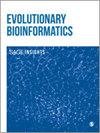Toward a Better Understanding of G4 Evolution in the 3 Living Kingdoms.
IF 1.5
4区 生物学
Q4 EVOLUTIONARY BIOLOGY
Evolutionary Bioinformatics
Pub Date : 2023-12-01
eCollection Date: 2023-01-01
DOI:10.1177/11769343231212075
引用次数: 0
Abstract
Background: G-quadruplexes (G4s) are secondary structures in DNA and RNA that impact various cellular processes, such as transcription, splicing, and translation. Due to their numerous functions, G4s are involved in many diseases, making their study important. Yet, G4s evolution remains largely unknown, due to their low sequence similarity and the poor quality of their sequence alignments across several species. To address this, we designed a strategy that avoids direct G4s alignment to study G4s evolution in the 3 species kingdoms. We also explored the coevolution between RBPs and G4s. Methods: We retrieved one-to-one orthologous genes from the Ensembl Compara database and computed groups of one-to-one orthologous genes. For each group, we aligned gene sequences and identified G4 families as groups of overlapping G4s in the alignment. We analyzed these G4 families using Count, a tool to infer feature evolution into a gene or a species tree. Additionally, we utilized these G4 families to predict G4s by homology. To establish a control dataset, we performed mono-, di- and tri-nucleotide shuffling. Results: Only a few conserved G4s occur among all living kingdoms. In eukaryotes, G4s exhibit slight conservation among vertebrates, and few are conserved between plants. In archaea and bacteria, at most, only 2 G4s are common. The G4 homology-based prediction increases the number of conserved G4s in common ancestors. The coevolution between RNA-binding proteins and G4s was investigated and revealed a modest impact of RNA-binding proteins evolution on G4 evolution. However, the details of this relationship remain unclear. Conclusion: Even if G4 evolution still eludes us, the present study provides key information to compute groups of homologous G4 and to reveal the evolution history of G4 families.更好地理解三个生物王国的G4进化。
背景:g -四plex (G4s)是DNA和RNA中的二级结构,影响各种细胞过程,如转录、剪接和翻译。由于其众多的功能,G4s与许多疾病有关,因此对它们的研究很重要。然而,由于G4s的序列相似性较低,并且在多个物种之间的序列比对质量较差,因此G4s的进化在很大程度上仍然未知。为了解决这个问题,我们设计了一个避免直接G4s对齐的策略来研究3个物种王国的G4s进化。我们还探讨了rbp和G4s之间的共同进化。方法:从Ensembl Compara数据库中检索一对一同源基因,计算一对一同源基因组。对于每个组,我们对基因序列进行比对,并将G4家族鉴定为在比对中重叠的G4组。我们使用Count来分析这些G4家族,这是一种推断基因或物种树特征进化的工具。此外,我们利用这些G4家族进行同源性预测。为了建立对照数据集,我们进行了单核苷酸、二核苷酸和三核苷酸洗牌。结果:在所有生物王国中只存在少数保守的G4s。在真核生物中,G4s在脊椎动物中表现出轻微的保守性,而在植物之间则很少保守。在古细菌和细菌中,最多只有2个G4s是常见的。基于G4同源性的预测增加了共同祖先中保守的G4数量。研究了rna结合蛋白与G4的协同进化,发现rna结合蛋白的进化对G4的进化有一定的影响。然而,这种关系的细节尚不清楚。结论:尽管G4的进化仍不清楚,但本研究为计算同源G4群和揭示G4家族的进化史提供了关键信息。
本文章由计算机程序翻译,如有差异,请以英文原文为准。
求助全文
约1分钟内获得全文
求助全文
来源期刊

Evolutionary Bioinformatics
生物-进化生物学
CiteScore
4.20
自引率
0.00%
发文量
25
审稿时长
12 months
期刊介绍:
Evolutionary Bioinformatics is an open access, peer reviewed international journal focusing on evolutionary bioinformatics. The journal aims to support understanding of organismal form and function through use of molecular, genetic, genomic and proteomic data by giving due consideration to its evolutionary context.
 求助内容:
求助内容: 应助结果提醒方式:
应助结果提醒方式:


